An Introduction to GCC
for the GNU Compilers gcc and g++
Brian Gough
Foreword by Richard M. Stallman
�
A catalogue record for this book is available from the British Library.
First printing, March 2004 (7/3/2004).
Published by Network Theory Limited.
15 Royal Park
Bristol
BS8 3AL
United Kingdom
Email: info@network-theory.co.uk
ISBN 0-9541617-9-3
Further information about this book is available from
http://www.network-theory.co.uk/gcc/intro/
Cover Image: From a layout of a fast, energy-efficient hardware stack.(1)
Image created with the free Electric VLSI design system by Steven Rubin
of Static Free Software (www.staticfreesoft.com). Static Free Software
provides support for Electric to the electronics design industry.
Copyright c 2004 Network Theory Ltd.
Permission is granted to copy, distribute and/or modify this document
under the terms of the GNU Free Documentation License, Version 1.2
or any later version published by the Free Software Foundation; with no
Invariant Sections, with the Front-Cover Texts being “A Network Theory
Manual”, and with the Back-Cover Texts as in (a) below. A copy of
the license is included in the section entitled “GNU Free Documentation
License”.
(a) The Back-Cover Text is: “The development of this manual was funded
entirely by Network Theory Ltd. Copies published by Network Theory
Ltd raise money for more free documentation.”
The Texinfo source for this manual may be obtained from:
http://www.network-theory.co.uk/gcc/intro/src/
(1)
“A Fast and Energy-Efficient Stack” by J. Ebergen, D. Finchelstein, R. Kao,
J. Lexau and R. Hopkins.
�
i
Table of Contents
Foreword . . . . . . . . . . . . . . . . . . . . . . . . . . . . . . . 1
1 Introduction . . . . . . . . . . . . . . . . . . . . . . . . . 3
1.1 A brief history of GCC . . . . . . . . . . . . . . . . . . . . . . . . . . . . . . . 3
1.2 Major features of GCC . . . . . . . . . . . . . . . . . . . . . . . . . . . . . . . 4
1.3 Programming in C and C++ . . . . . . . . . . . . . . . . . . . . . . . . . . . 4
1.4 Conventions used in this manual. . . . . . . . . . . . . . . . . . . . . . . 5
2 Compiling a C program . . . . . . . . . . . . . . 7
2.1 Compiling a simple C program . . . . . . . . . . . . . . . . . . . . . . . . 7
2.2 Finding errors in a simple program . . . . . . . . . . . . . . . . . . . . 8
2.3 Compiling multiple source files . . . . . . . . . . . . . . . . . . . . . . . . 9
2.4 Compiling files independently . . . . . . . . . . . . . . . . . . . . . . . . 10
2.4.1 Creating object files from source files . . . . . . . . 11
2.4.2 Creating executables from object files. . . . . . . . 11
2.4.3 Link order of object files. . . . . . . . . . . . . . . . . . . . 12
2.5 Recompiling and relinking . . . . . . . . . . . . . . . . . . . . . . . . . . . 13
2.6 Linking with external libraries . . . . . . . . . . . . . . . . . . . . . . . 14
2.6.1 Link order of libraries . . . . . . . . . . . . . . . . . . . . . . 15
2.7 Using library header files . . . . . . . . . . . . . . . . . . . . . . . . . . . . 16
3 Compilation options . . . . . . . . . . . . . . . . . 19
3.1 Setting search paths . . . . . . . . . . . . . . . . . . . . . . . . . . . . . . . . . 19
3.1.1 Search path example . . . . . . . . . . . . . . . . . . . . . . . 20
3.1.2 Environment variables. . . . . . . . . . . . . . . . . . . . . . 21
3.1.3 Extended search paths . . . . . . . . . . . . . . . . . . . . . 22
3.2 Shared libraries and static libraries . . . . . . . . . . . . . . . . . . . 23
3.3 C language standards. . . . . . . . . . . . . . . . . . . . . . . . . . . . . . . . 25
3.3.1 ANSI/ISO. . . . . . . . . . . . . . . . . . . . . . . . . . . . . . . . . 26
3.3.2 Strict ANSI/ISO . . . . . . . . . . . . . . . . . . . . . . . . . . . 28
3.3.3 Selecting specific standards . . . . . . . . . . . . . . . . . 28
3.4 Warning options in -Wall. . . . . . . . . . . . . . . . . . . . . . . . . . . . 29
3.5 Additional warning options . . . . . . . . . . . . . . . . . . . . . . . . . . 30
�
ii
An Introduction to GCC
4 Using the preprocessor . . . . . . . . . . . . . . 35
4.1 Defining macros . . . . . . . . . . . . . . . . . . . . . . . . . . . . . . . . . . . . . 35
4.2 Macros with values . . . . . . . . . . . . . . . . . . . . . . . . . . . . . . . . . . 36
4.3 Preprocessing source files . . . . . . . . . . . . . . . . . . . . . . . . . . . . 38
5 Compiling for debugging . . . . . . . . . . . . 41
5.1 Examining core files . . . . . . . . . . . . . . . . . . . . . . . . . . . . . . . . . 41
5.2 Displaying a backtrace. . . . . . . . . . . . . . . . . . . . . . . . . . . . . . . 43
6 Compiling with optimization . . . . . . . . . 45
6.1 Source-level optimization . . . . . . . . . . . . . . . . . . . . . . . . . . . . 45
6.1.1 Common subexpression elimination. . . . . . . . . . 45
6.1.2 Function inlining. . . . . . . . . . . . . . . . . . . . . . . . . . . 46
6.2 Speed-space tradeoffs . . . . . . . . . . . . . . . . . . . . . . . . . . . . . . . . 47
6.2.1 Loop unrolling . . . . . . . . . . . . . . . . . . . . . . . . . . . . . 47
6.3 Scheduling. . . . . . . . . . . . . . . . . . . . . . . . . . . . . . . . . . . . . . . . . . 49
6.4 Optimization levels . . . . . . . . . . . . . . . . . . . . . . . . . . . . . . . . . . 49
6.5 Examples . . . . . . . . . . . . . . . . . . . . . . . . . . . . . . . . . . . . . . . . . . . 50
6.6 Optimization and debugging . . . . . . . . . . . . . . . . . . . . . . . . . 52
6.7 Optimization and compiler warnings . . . . . . . . . . . . . . . . . . 53
7 Compiling a C++ program . . . . . . . . . . . 55
7.1 Compiling a simple C++ program . . . . . . . . . . . . . . . . . . . . . 55
7.2 Using the C++ standard library. . . . . . . . . . . . . . . . . . . . . . . 56
7.3 Templates . . . . . . . . . . . . . . . . . . . . . . . . . . . . . . . . . . . . . . . . . . 57
7.3.1 Using C++ standard library templates . . . . . . . 57
7.3.2 Providing your own templates. . . . . . . . . . . . . . . 58
7.3.3 Explicit template instantiation . . . . . . . . . . . . . . 60
7.3.4 The export keyword . . . . . . . . . . . . . . . . . . . . . . . 61
8 Platform-specific options . . . . . . . . . . . . 63
Intel and AMD x86 options . . . . . . . . . . . . . . . . . . . . . . . . . . 63
8.1
8.2 DEC Alpha options . . . . . . . . . . . . . . . . . . . . . . . . . . . . . . . . . 64
8.3 SPARC options . . . . . . . . . . . . . . . . . . . . . . . . . . . . . . . . . . . . . 65
8.4 POWER/PowerPC options . . . . . . . . . . . . . . . . . . . . . . . . . . 65
8.5 Multi-architecture support . . . . . . . . . . . . . . . . . . . . . . . . . . . 66
9 Troubleshooting. . . . . . . . . . . . . . . . . . . . . 69
9.1 Help for command-line options . . . . . . . . . . . . . . . . . . . . . . . 69
9.2 Version numbers . . . . . . . . . . . . . . . . . . . . . . . . . . . . . . . . . . . . 69
9.3 Verbose compilation . . . . . . . . . . . . . . . . . . . . . . . . . . . . . . . . . 70
�
iii
10 Compiler-related tools. . . . . . . . . . . . . . 73
10.1 Creating a library with the GNU archiver . . . . . . . . . . . . 73
10.2 Using the profiler gprof . . . . . . . . . . . . . . . . . . . . . . . . . . . . 75
10.3 Coverage testing with gcov . . . . . . . . . . . . . . . . . . . . . . . . . 77
11 How the compiler works . . . . . . . . . . . . 81
11.1 An overview of the compilation process . . . . . . . . . . . . . . 81
11.2 The preprocessor . . . . . . . . . . . . . . . . . . . . . . . . . . . . . . . . . . . 81
11.3 The compiler . . . . . . . . . . . . . . . . . . . . . . . . . . . . . . . . . . . . . . 82
11.4 The assembler . . . . . . . . . . . . . . . . . . . . . . . . . . . . . . . . . . . . . 83
11.5 The linker . . . . . . . . . . . . . . . . . . . . . . . . . . . . . . . . . . . . . . . . . 83
12 Examining compiled files . . . . . . . . . . . 85
Identifying files . . . . . . . . . . . . . . . . . . . . . . . . . . . . . . . . . . . . 85
12.1
12.2 Examining the symbol table . . . . . . . . . . . . . . . . . . . . . . . . 86
12.3 Finding dynamically linked libraries . . . . . . . . . . . . . . . . . 86
13 Getting help . . . . . . . . . . . . . . . . . . . . . . . 89
Further reading . . . . . . . . . . . . . . . . . . . . . . . . 91
Acknowledgements . . . . . . . . . . . . . . . . . . . . . 93
Other books from the publisher . . . . . . . . . 95
Free software organizations . . . . . . . . . . . . . 97
GNU Free Documentation License . . . . . . 99
ADDENDUM: How to use this License for your
documents. . . . . . . . . . . . . . . . . . . . . . . . . . . . . . . . . . 104
Index . . . . . . . . . . . . . . . . . . . . . . . . . . . . . . . . . 105
�
iv
An Introduction to GCC
�
Foreword
1
Foreword
This foreword has been kindly contributed by Richard M. Stallman, the
principal author of GCC and founder of the GNU Project.
This book is a guide to getting started with GCC, the GNU Compiler
Collection. It will tell you how to use GCC as a programming tool. GCC
is a programming tool, that’s true—but it is also something more. It is
part of a 20-year campaign for freedom for computer users.
We all want good software, but what does it mean for software to
be “good”? Convenient features and reliability are what it means to be
technically good, but that is not enough. Good software must also be
ethically good: it has to respect the users’ freedom.
As a user of software, you should have the right to run it as you see
fit, the right to study the source code and then change it as you see fit,
the right to redistribute copies of it to others, and the right to publish a
modified version so that you can contribute to building the community.
When a program respects your freedom in this way, we call it free software.
Before GCC, there were other compilers for C, Fortran, Ada, etc. But
they were not free software; you could not use them in freedom. I wrote
GCC so we could use a compiler without giving up our freedom.
A compiler alone is not enough—to use a computer system, you need
a whole operating system. In 1983, all operating system for modern com-
puters were non-free. To remedy this, in 1984 I began developing the
GNU operating system, a Unix-like system that would be free software.
Developing GCC was one part of developing GNU.
By the early 90s, the nearly-finished GNU operating system was com-
pleted by the addition of a kernel, Linux, that became free software in
1992. The combined GNU/Linux operating system has achieved the goal
of making it possible to use a computer in freedom. But freedom is never
automatically secure, and we need to work to defend it. The Free Software
Movement needs your support.
Richard M. Stallman
February 2004
�
2
An Introduction to GCC
�
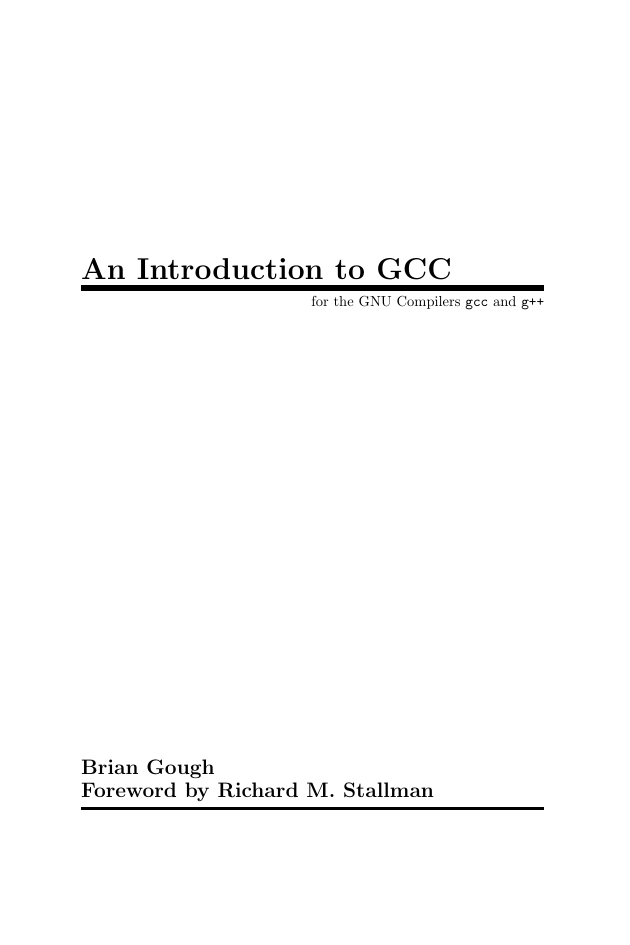

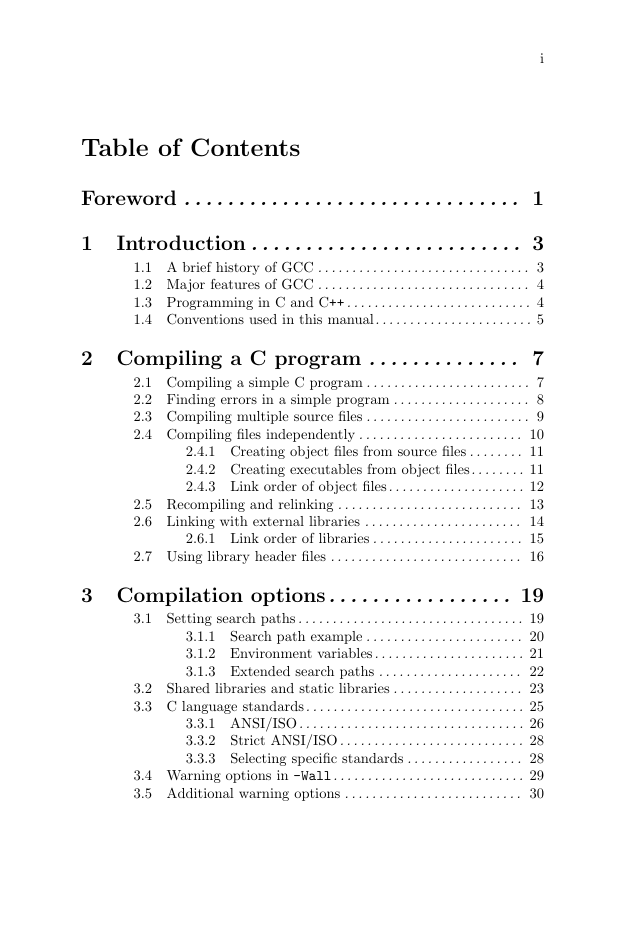
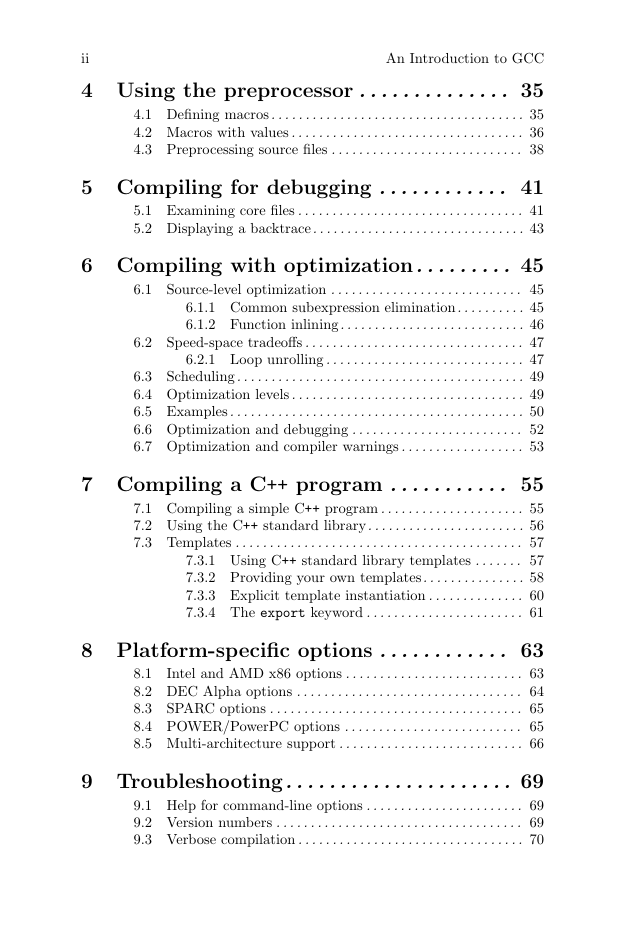
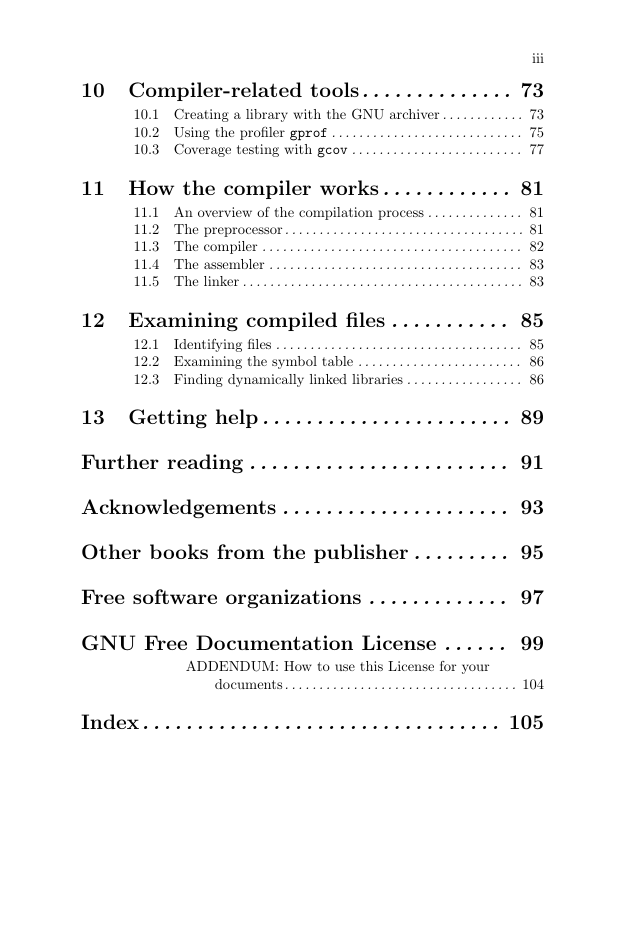

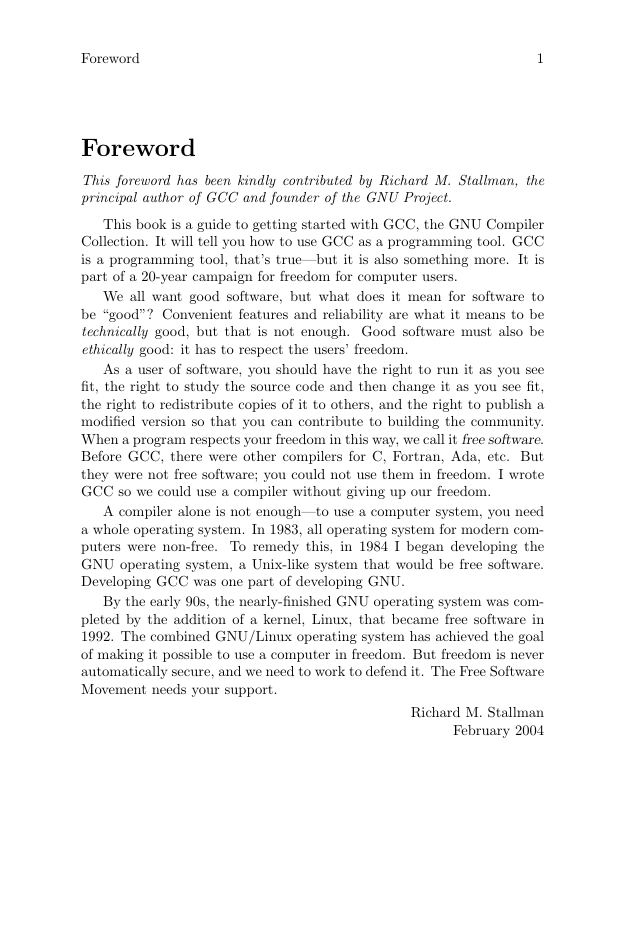









 2023年江西萍乡中考道德与法治真题及答案.doc
2023年江西萍乡中考道德与法治真题及答案.doc 2012年重庆南川中考生物真题及答案.doc
2012年重庆南川中考生物真题及答案.doc 2013年江西师范大学地理学综合及文艺理论基础考研真题.doc
2013年江西师范大学地理学综合及文艺理论基础考研真题.doc 2020年四川甘孜小升初语文真题及答案I卷.doc
2020年四川甘孜小升初语文真题及答案I卷.doc 2020年注册岩土工程师专业基础考试真题及答案.doc
2020年注册岩土工程师专业基础考试真题及答案.doc 2023-2024学年福建省厦门市九年级上学期数学月考试题及答案.doc
2023-2024学年福建省厦门市九年级上学期数学月考试题及答案.doc 2021-2022学年辽宁省沈阳市大东区九年级上学期语文期末试题及答案.doc
2021-2022学年辽宁省沈阳市大东区九年级上学期语文期末试题及答案.doc 2022-2023学年北京东城区初三第一学期物理期末试卷及答案.doc
2022-2023学年北京东城区初三第一学期物理期末试卷及答案.doc 2018上半年江西教师资格初中地理学科知识与教学能力真题及答案.doc
2018上半年江西教师资格初中地理学科知识与教学能力真题及答案.doc 2012年河北国家公务员申论考试真题及答案-省级.doc
2012年河北国家公务员申论考试真题及答案-省级.doc 2020-2021学年江苏省扬州市江都区邵樊片九年级上学期数学第一次质量检测试题及答案.doc
2020-2021学年江苏省扬州市江都区邵樊片九年级上学期数学第一次质量检测试题及答案.doc 2022下半年黑龙江教师资格证中学综合素质真题及答案.doc
2022下半年黑龙江教师资格证中学综合素质真题及答案.doc